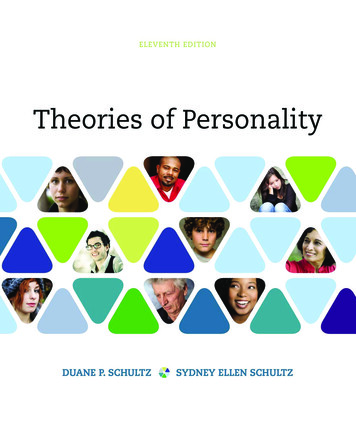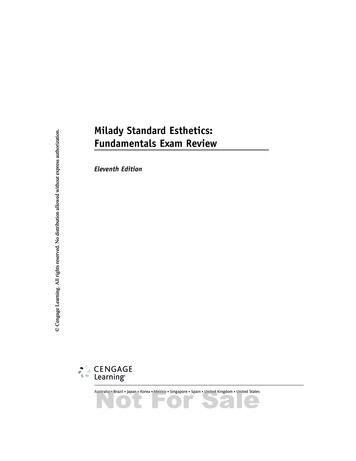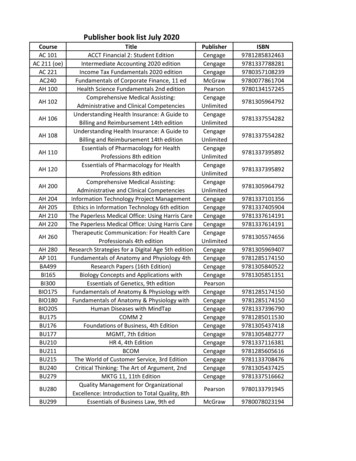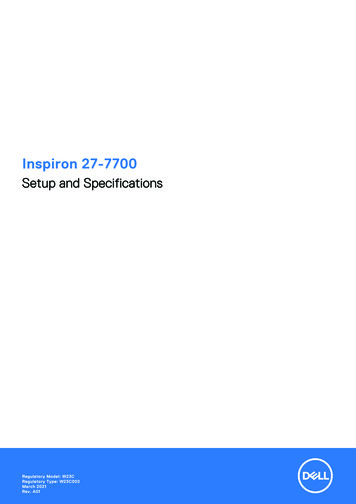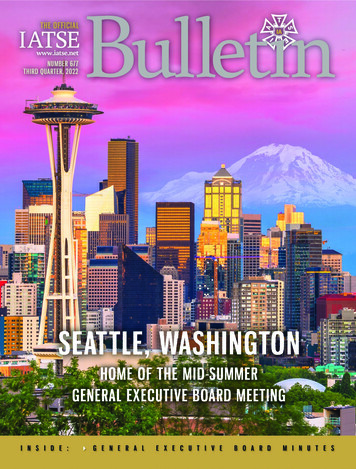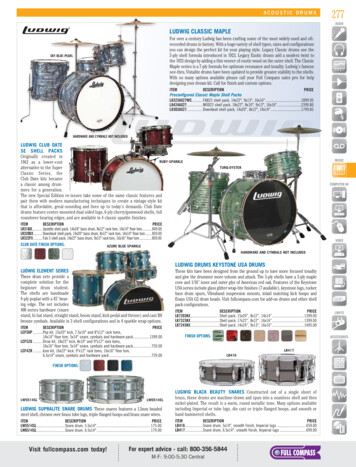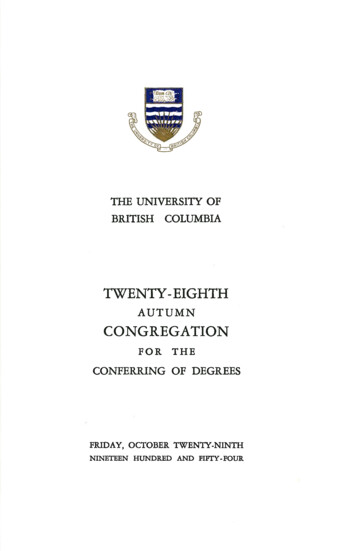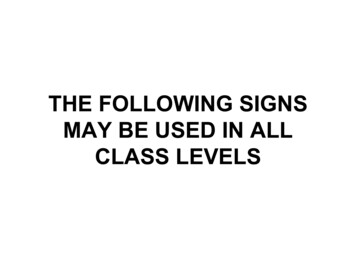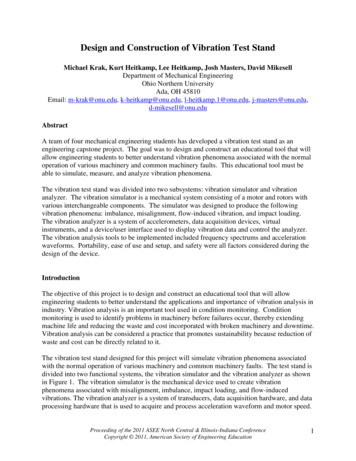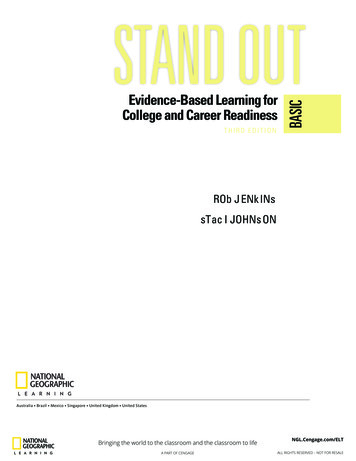
Transcription
Evidence-Based Learning forCollege and Career ReadinessTHIRD EDITIONROb J ENk INssTac I JOHNs ONAustralia Brazil Mexico Singapore United Kingdom United StatesBASICSTAND OUT
Stand Out Basic: Evidence-Based Learningfor College and Career Readiness,Third EditionRob Jenkins and Staci JohnsonPublisher: Sherrise RoehrExecutive Editor: Sarah KenneyDevelopment Editor: Lewis ThompsonDirector of Global Marketing: Ian MartinExecutive Marketing Manager: Ben RiveraProduct Marketing Manager: Dalia BravoDirector of Content and Media Production:Michael BurggrenProduction Manager: Daisy SosaMedia Researcher: Leila HishmehSenior Print Buyer: Mary Beth HenneburyCover and Interior Designer:Brenda CarmichaelComposition: LuminaMain Image: Portra Images/Getty ImagesBottom Images: (Left to Right) Jay B Sauceda/Getty Images; Tripod/Getty Images;Dear Blue/Getty Images; Portra Images/Getty Images; Mark Edward Atkinson/Tracey Lee/Getty Images; Hero Images/Getty Images; Jade/Getty Images; Seth Joel/Getty Images; LWA/Larry Williams/Getty Images; Dimitri Otis/Getty Images 2016 National Geographic Learning, a part of Cengage LearningALL RIGHTS RESERVED. No part of this work covered by the copyright hereinmay be reproduced, transmitted, stored or used in any form or by any meansgraphic, electronic, or mechanical, including but not limited to photocopying,recording, scanning, digitising, taping, Web distribution, information networks,or information storage and retrieval systems, except as permitted underSection 107 or 108 of the 1976 United States Copyright Act, or applicablecopyright law of another jurisdiction, without the prior written permission ofthe publisher.National Geographic and the Yellow Border are registered trademarks of theNational Geographic Society.For permission to use material from this text or product, submit all requestsonline at cengage.com/permissionsFurther permissions questions can be emailed to permissionrequest@cengage.comStudent BookISBN 13: 978-1-305-65520-1National Geographic Learning/Cengage Learning20 Channel Center StreetBoston, MA 02210USACengage Learning is a leading provider of customized learning solutions withoffice locations around the globe, including Singapore, the United Kingdom,Australia, Mexico, Brazil, and Japan. Locate your local office at:international.cengage.com/regionCengage Learning products are represented in Canada by Nelson Education, Ltd.Visit National Geographic Learning online at NGL.Cengage.comVisit our corporate website at www.cengage.comPrinted in the United States of AmericaPrint Number: 01 Print Year: 2015
AcknowledgmentsEllen AlbanoMcfatter Technical College, Davie, FLFrantz Jean-LouisThe English Center, Miami, FLEsther Anaya-GarciaGlendale Community College, Glendale, AZAnnette JohnsonSheridan Technical College, Hollywood, FLCarol BellamyPrince George’s Community College, Largo, MDGinger KarawayGateway Technical College, Kenosha, WIGail BierAtlantic Technical College, Coconut Creek, FLJudy Martin-HallIndian River State College, Fort Pierce, FLKathryn BlackMyrtle Beach Family Learning Center, Myrtle Beach, SCToni MolinaroDixie Hollins Adult Education Center, St Petersburg, FLClaudia BrantleyCollege of Southern Nevada, Las Vegas, NVTracey PersonCape Cod Community College, Hyannis, MADr. Joan-Yvette CampbellLindsey Hopkins Technical College, Miami, FLCelina PaulaMiami-Dade County Public Schools, Miami, FLMaria Carmen IglesiasMiami Senior Adult Educational Center, Miami, FLVeronica Pavon-BakerMiami Beach Adult, Miami, FLLee ChenPalomar College, San Marcos, CAIleana PerezRobert Morgan Technical College, Miami, FLCasey CahillAtlantic Technical College, Coconut Creek, FLNeeta RancourtAtlantic Technical College, Coconut Creek, FLMaria DillehayBurien Job Training and Education Center, Goodwill,Seattle, WABrenda RolandJoliet Junior College, Joliet, ILIrene FjaerestadOlympic College, Bremerton, WAEleanor Forfang-BrockmanTarrant County College, Fort Worth, TexasJesse GaldamezSan Bernardino Adult School, San Bernardino, CAHidelisa SampsonLas Vegas Urban League, Las Vegas, NVLisa SchickJames Madison University, Harrisonburg, VARob SheppardQuincy Asian Resources, Quincy, MAAnna GarozLindsey Hopkins Technical Education Center, Miami, FLSydney SilverBurien Job Training and Education Center, Goodwill, Seattle, WAMaria GutierrezMiami Sunset Adult, Miami, FLTeresa TamaritMiami Senior Adult Educational Center, Miami, FLNoel HernandezPalm Beach County Public Schools, Palm Beach County, FLCristina UrenaAtlantic Technical College, Fort Lauderdale, FLKathleen HiscockPortland Adult Education, Portland, MEPamela Jo WilsonPalm Beach County Public Schools, Palm Beach County, FLAcknowledgmentsiii
About the AuthorsRob JenkinsI love teaching. I love to see the expressions onmy students’ faces when the light goes on andtheir eyes show such sincere joy of learning.I knew the first time I stepped into an ESLclassroom that this is where I needed to be andI have never questioned that resolution. I haveworked in business, sales, and publishing, andI’ve found challenge in all, but nothing cancompare to the satisfaction of reaching peoplein such a personal way.Staci JohnsonEver since I can remember, I’ve been fascinated withother cultures and languages. I love to travel andevery place I go, the first thing I want to do is meetthe people, learn their language, and understandtheir culture. Becoming an ESL teacher was a perfectway to turn what I love to do into my profession.There’s nothing more incredible than the exchangeof teaching and learning from one another thatgoes on in an ESL classroom. And there’s nothingmore rewarding than helping a student succeed.Along with the inclusion of National Geographic content, the third edition of Stand Out boasts of severalinnovations. In response to initiatives regarding the development of more complexity with reading andencouraging students to interact more with reading texts, we are proud to introduce new rich reading sectionsthat allow students to discuss topics relevant to a global society. We have also introduced new National Geographicvideos that complement the life-skill videos Stand Out introduced in the second edition and which are nowintegrated into the student books. We don’t stop there; Stand Out has even more activities that require critical andcreative thinking that serve to maximize learning and prepare students for the future. The third edition also has onlineworkbooks. Stand Out was the first mainstream ESL textbook for adults to introduce a lesson plan format, hundredsof customizable worksheets, and project-based instruction. The third edition expands on these features in its missionto provide rich learning opportunities that can be exploited in different ways. We believe that with the innovativeapproach that made Stand Out a leader from its inception, the many new features, and the new look; programs,teachers, and students will find great success!Stand Out Mission Statement:Our goal is to give students challenging opportunities to be successful in their language learning experience so theydevelop confidence and become independent lifelong learners.ivAbout the Authors
To the TeacherABOUT THE SERIESThe Stand Out series is designed to facilitate activelearning within life-skill settings that lead students tocareer and academic pathways. Each student book andits supplemental components in the six-level seriesexpose students to competency areas most useful andessential for newcomers with careful treatment of levelappropriate but challenging materials. Students growacademically by developing essential literacy and criticalthinking skills that will help them find personal successin a changing and dynamic world.THE STAND OUT PHILOSOPHYIntegrated SkillsIn each of the five lessons of every unit, skills areintroduced as they might be in real language use. Theyare in context and not separated into different sectionsof the unit. We believe that for real communication tooccur, the classroom should mirror real-life as much aspossible.Objective Driven ActivitiesEvery lesson in Stand Out is driven by a performanceobjective. These objectives have been carefully selectedto ensure they are measurable, accessible to students attheir particular level, and relevant to students and theirlives. Good objectives lead to effective learning. Effectiveobjectives also lead to appropriate self, student, andprogram assessment which is increasingly required bystate and federal mandates.Lesson Plan SequencingStand Out follows an established sequence of activitiesthat provides students with the tools they need to havein order to practice and apply the skills required in theobjective. A pioneer in Adult Education for introducing theMadeline Hunter WIPPEA lesson plan model into textbooks,Stand Out continues to provide a clear and easy-to-followsystem for presenting and developing English languageskills. The WIPPEA model follows six steps: Warm up and plicationLearning And AcquisitionIn Stand Out, the recycling of skills is emphasized.Students must learn and practice the same skillsmultiple times in various contexts to actually acquirethem. Practicing a skill one time is rarely sufficient foracquisition and rarely addresses diverse student needsand learning styles.Critical ThinkingCritical thinking has been defined in various waysand sometimes so broadly that any activity could beclassified to meet the criteria. To be clear and to drawattention to the strong critical thinking activities inStand Out, we define these activities as tasks thatrequire learners to think deeper than the superficialvocabulary and meaning. Activities such as ranking,making predictions, analyzing, or solving problems,demand that students think beyond the surface. Criticalthinking is highlighted throughout so the instructor canbe confident that effective learning is going on.Learner-Centered, Cooperative, andCommunicative ActivitiesStand Out provides ample opportunities for studentsto develop interpersonal skills and to practice newvocabulary through graphic organizers and charts likeVENN diagrams, graphs, classifying charts, and mind maps.The lesson planners provide learner-centered approachesin every lesson. Students are asked to rank items, makedecisions, and negotiate amongst other things.Dialogues are used to prepare students for these activitiesin the low levels and fewer dialogues are used at thehigher levels where students have already acquired thevocabulary and rudimentary conversation skills.Activities should provide opportunities for students tospeak in near authentic settings so they have confidenceto perform outside the classroom. This does not meanthat dialogues and other mechanical activities are notused to prepare students for cooperative activities, butthese mechanical activities do not foster conversation.They merely provide the first tools students need to gobeyond mimicry.AssessmentInstructors and students should have a clearunderstanding of what is being taught and what is expected. In Stand Out, objectives are clearly stated sothat target skills can be effectively assessed throughout.To the Teacherv
Formative assessments are essential. Pre andpost-assessments can be given for units or sections ofthe book through ExamView—a program that makesdeveloping tests easy and effective. These tests can becreated to appear like standardized tests, which areimportant for funding and to help students prepare.Stand Out Online WorkbookFinally, learner logs allow students to self-assess,document progress, and identify areas that mightrequire additional attention.The online workbook provides opportunities forstudents to practice and improve digital literacy skillsessential for 21st century learners. These skills areessential for standardized computer and online testing.Scores in these tests will improve when students canconcentrate on the content and not so much on thetechnology.SUPPLEMENTAL COMPONENTSThe Stand Out series is a comprehensive one-stop for allstudent needs. There is no need to look any further thanthe resources offered.Stand Out Lesson PlannersThe lesson planners go beyond merely describingactivities in the student book by providing teachersupport, ideas, and guidance for the entire class period.One of the most important innovations new to thethird edition of Stand Out is the online workbook.This workbook provides unique activities that areclosely related to the student book and gives studentsopportunities to have access to audio and video.Activity BankThe Activity Bank is an online feature that provides several hundred multilevel worksheets per level to enhance the already rich materials available throughStand Out. Standards correlations for CCRS, CASAS, andSCANS are identified for each lesson. Pacing Guides help with planning by givinginstructors suggested durations for each activity and aselection of activities for different class lengths. Teacher Tips provide point-of-use pedagogicalcomments and best practices. At-A-Glance Lesson Openers provide the instructorwith everything that will be taught in a particularlesson. Elements include, the agenda, the goal,grammar, pronunciation, academic strategies, criticalthinking elements, correlations to standards, andresources. Suggested Activities go beyond what is shown in thetext providing teachers with ideas that will stimulatethem to come up with their own. Listening Scripts are integrated into the unit pagesfor easy access.Stand Out WorkbookThe workbook in the third edition takes the popularStand Out Grammar Challenge and expands it toinclude vocabulary building, life-skill development, andgrammar practice associated directly with each lesson inthe student book.vi To the TeacherDVD ProgramThe Stand Out Lifeskills Video Program continuesto be available with eight episodes per level; however,now the worksheets are part of the student books with additional help in the lesson planners.New to the third edition of Stand Out are two NationalGeographic videos per level. Each video is accompaniedby four pages of instruction and activities with supportin the lesson planners.ExamviewExamView is a program that provides customizable testbanks and allows instructors to make lesson, unit, andprogram tests quickly.STANDARDS AND CORRELATIONSStand Out is the pioneer in establishing afoundation of standards within each unit andthrough every objective. The standards movementin the United States is as dominant today as it waswhen Stand Out was first published. Schools andprograms must be aware of on-going local and federalinitiatives and make attempts to meet ever-changingrequirements.
In the first edition of Stand Out, we identified directcorrelations to SCANS, EFF, and CASAS standards.The Secretaries Commission on Achieving NecessarySkills or SCANS and Equipped for the Future or EFFstandards are still important and are identified in everylesson of Stand Out. These skills include the basic skills,interpersonal skills, and problem-solving skills necessaryto be successful in the workplace, in school, and inthe community. Stand Out was also developed with athorough understanding of objectives established bythe Comprehensive Adult Student Assessment Systems orCASAS. Many programs have experienced great successwith their CASAS scores using Stand Out, and theseobjectives continue to be reflected in the third edition.Today, a new emphasis on critical thinking andcomplexity has swept the nation. Students are expectedto think for themselves more now than ever before.They must also interact with reading texts at a higherlevel. These new standards and expectations are highlyvisible in the third edition and include College and CareerReadiness Standards.Stand Out offers a complete set of correlations onlinefor all standards to demonstrate how closely we alignwith state and federal guidelines.education, it now has an updated look with theaddition of the National Geographic content whichwill capture the attention of the instructor and everystudent.Critical ThinkingWith the advent of new federal and state initiatives,teachers need to be confident that students will usecritical thinking skills when learning. This has alwaysbeen a goal in Stand Out, but now those opportunitiesare highlighted in each lesson.College And Career Readiness SkillsThese skills are also identified by critical thinkingstrategies and academic-related activities whichare found throughout Stand Out. New to the thirdedition is a special reading section in each unit thatchallenges students and encourages them to developreading strategies within a rich National Geographicenvironment.Stand Out WorkbookIMPORTANT INNOVATIONSTO THE THIRD EDITIONThe print workbook is now more extensive andcomplete with vocabulary, life skills, and grammaractivities to round out any program. Many instructorsmight find these pages ideal for homework, but theyof course can be used for additional practice withinthe classroom.New LookMedia And Online SupportAlthough the third edition of Stand Out boasts ofthe same lesson plan format and task-based activitiesthat made it one of the most popular books in adultMedia and online support includes audio, video, online workbooks, presentation tools, and multi-level worksheets, ExamView, and standards correlations.To the Teachervii
Th e meCONTENTSUnit andPage NumberEL CivicsCompetencies/Grammar Life SkillspeoplePre-Unit GreetSay and write phoneWelcomePage 2Basic Communication1Personal InformationPage 122Our ClassPage 36viii Contents numbers Follow instructions Identify people Express nationalities Express marital status Say and writeGrammarVocabulary The verb Be Contractions Alphabet and numbers Final consonant /t/ hello, hi, goodbye, bye /m/ Classroom verbs: listen,with BePronunciationpoint, practice, read,write Simple present Months of the year: Question rhythm Emphasis Say and write datestense The verb Be Contractions withBe Wh- questions Introduce yourself Possessive Weather vocabulary: Question intonation Emphasisaddressesand others Describe yoursurroundings Identify commonactivities Plan a schedule Plan for weatheradjectives This is . . . Prepositions oflocation Presentcontinuous Simple presentwith needmonth, day, year Marital status: single,married, divorced Address vocabulary:city, state, zip codefoggy, cloudy, rainy,windy, sunny, snowy, hot,cold Verbs: listening, reading,writing, talking, sitting,standing Classroom nouns Clothing
Numeracy/Academic SkillsCCRSSCANSCASASSL1, SL2, L2, RF2, RF3Many SCAN skills areincorporated in this unitwith an emphasis on: Listening Speaking Writing Sociability Acquiring and evaluatinginformation Interpreting andcommunicatinginformation1: 0.1.1, 0.1.4, 0.2.12: 0.1.1, 0.1.4, 0.2.13: 0.1.5, 7.4.7R: 7.4.1, 7.4.2, 7.4.3 Writing numerals 1-31 Writing dates Focused listening Teamwork skills Reviewing Evaluating Developing study skillsRI1, RI7, SL1, SL2, SL4, L1,L2, L5, RF2, RF3Many SCAN skills areincorporated in this unitwith an emphasis on: Basic skills Acquiring and evaluatinginformation Interpreting andcommunicatinginformation Seeing things in themind’s eye Sociability1: 0.1.1, 0.2.12: 0.1.2, 0.2.1, 1.1.3, 4.8.73: 0.1.2, 0.2.14: 0.1.2, 0.2.1, 1.1.3, 4.8.75: 0.1.2, 0.2.1, 2.3.2R: 0.1.1, 0.2.1, 7.4.1, 7.4.2,7.4.3TP: 0.1.1, 0.2.1, 4.8.1 Interpreting a bar graph Telling time Focused listening Scheduling Reviewing Evaluating Developing study skillsRI1, RI7, SL1, SL2, SL4, L1,L2, L5, RF2, RF3Many SCAN skills areincorporated in this unitwith an emphasis on: Acquiring and evaluatinginformation Organizing andmaintaining information Interpreting andcommunicatinginformationBasicskills Reflectand Evaluate 1: 0.1.42: 0.1.53: 0.1.54: 0.2.1, 0.2.4, 2.3.15: 0.1.2, 0.2.1, 1.1.3, 2.3.3R: 0.1.5, 2.3.1, 2.3.2, 2.3.3,7.4.1, 7.4.2, 7.4.3TP: 0.1.5, 2.3.1, 2.3.2, 2.3.3,4.8.1 Writing numerals 1-9 Writing telephonenumbers Dictation Focused listening Class application Test-taking skillsContentsix
Th e meCONTENTSUnit andPage Number3FoodConsumer Econom i csPage 604ClothingPage 84EL CivicsCompetencies/Grammar Life SkillsGrammarVocabularyPronunciation Identify common Prepositions of Food items breakfast, lunch, dinner Recipe vocabulary Supermarket Plurals: /s/, /z/, /iz/foods Express hunger Plan meals Make a shopping list Express preferences Identify types ofclothing Ask for and givedirections in a store Describe clothing Make purchases Read advertisementsCommun it y R esourcesVIDEO CHALLENGE5OurCommunityPage 112x Contentslocation The verb Be Contractionswith Be Negative presenttense Forming singularand plural nouns Simple presentwith want, like,eat Simple presentwith have Forming pluralnouns The verb Be Prepositions oflocation How much/Howmany Articles Adjective/nounorder Wh- questionsPage 108 Identify and ask about Yes/No questionslocations on, in Describe housing a, an Identify types of Come and gotransportation Simple present Express personal The verb Beinformation Wh- questions Give and followdirectionsvocabulary Packaging vocabulary:bag, pound, can Articles of clothing Colors: red, yellow, blue,green, white, black Plurals: /s/, /z/, /iz/ Yes/No questions How much Money: bills and coinsA Mongolian Family Places in community Community locations Housing vocabulary:house, condominium,apartment, for sale,for rent Transportation nouns:car, bus, taxi, train,subway, bicycle Transportation verbs:drive, take, walk, ride Directions: stop, turnright/left, go straight Yes/No questions
Numeracy/Academic SkillsCCRSSCANSCASAS Using U.S. measurements:RI1, RI7, RI9, W1, W2, SL1,SL2, SL4, L1, L2, L5, RF2,RF3Many SCAN skills areincorporated in this unitwith an emphasis on: Acquiring and evaluatinginformation Organizing andmaintaining information Interpreting andcommunicatinginformation Allocating humanresources Basic skills Seeing things in themind’s eye1: 1.3.82: 1.3.83: 1.1.1, 1.3.84: 1.3.85: 1.3.8R: 1.3.8, 7.4.1, 7.4.2, 7.4.3TP: 1.88, 4.8.1 Using U.S.RI1, RI7, SL1, SL2, SL4, L1,L2, L5, RF2, RF3Many SCAN skills areincorporated in this unitwith an emphasis on: Acquiring and evaluatinginformation Organizing andmaintaining information Interpreting andcommunicatinginformation Basic skills Allocating money Serving clients andcustomers1: 1.3.92: 1.1.9, 1.2.1, 1.3.93: 1.1.9, 1.2.1, 1.3.94: 1.1.6, 1.3.9, 4.8.1, 6.1.15: 1.1.9, 1.2.1, 1.3.9, 4.8.3R: 1.1.9, 1.2.1, 1.3.9, 7.4.1,7.4.2, 7.4.3TP: 1.3.9, 4.8.1 Interpreting a bar graph Creating a bar graph Test-taking strategies Focused listening Dictation Reviewing Evaluating Developing study skillsRI1, RI7, SL1, SL2, SL4, L1,L2, L5, RF2, RF3Many SCAN skills areincorporated in this unitwith an emphasis on: Acquiring and evaluatinginformation Organizing andmaintaining information Interpreting andcommunicatinginformation Basic skills Creative thinking Participating as a memberof a team1: 1.3.7, 7.2.32: 1.4.1, 1.4.2, 1.9.43: 1.1.3, 2.2.3, 2.2.5, 6.7.24: 0.1.2, 0.2.45: 1.1.3, 1.9.1, 1.9.4, 2.2.1,2.2.2, 2.5.4R: 2.2.3, 7.4.1, 7.4.2, 7.4.3TP: 2.2.3, 4.8.1pounds, gallons Working in a group Focused listening Skimming Categorizing andorganizing information Teamwork skills Reviewing Evaluating Developing study skillsmeasurements:clothingsizes Maintaining inventories Counting U.S. money Calculating totals Writing checks Asking for information ‘ Focused listening Test-taking skills Reviewing Evaluating Developing study skillsContentsxi
Th e meCONTENTSUnit andPage NumberEL CivicsCompetencies/Grammar Life Skills6 Identify body parts Describe symptomsHea lthHealthyLivingPage 136and illnesses Identify medications Describe healthyhabits Identify actions in awaiting roomGrammarVocabularyPronunciation Imperatives Simple present Simple present Body parts: arm, back, /g/ Information Occupations: Yes/No questions The verb Be Imperatives Information Study tools: binders, Informationwith be Simple presentwith have Simple presentwith need Negative simplepresent PresentLifel ong Lear nin gO ccupational K nowledgecontinuous7WorkPage 1608LifelongLearningand ReviewPage 184 Identify occupations Give informationabout work Identify job duties Read evaluations Follow directions Organize studymaterials Make purchases Give and followdirections Make goals Develop a studyscheduleVIDEO CHALLENGExii Contentsquestions: when,where, what, who Modal: can andcan’t Simple present Negative simplepresent Affirmative andnegativecommandsquestions: where Prepositions offoot, hand, head, leg,neck Ailments: backache,cold, fever, headache,runny nose,stomachache Waiting room actions:talk, wait, read, answer,sleep Health vocabulary:checkup, exercise,smoke, mealsadministrative assistant,bus driver, cashier,custodian, doctor, nurse,receptionist, salesperson,store manager, student,teacher, worker Workplace vocabulary:answer, file, mop, type,wash Character adjectives:friendly, helpful, careful,cheerfuldividers, notebook,pencils, pens, sheets ofpaperquestionslocation Simple presentPage 208People of the Reindeer
Numeracy/Academic SkillsCCRSSCANSCASAS Focused listening Test-taking skills Reviewing Evaluating Developing study skillsRI1, RI2, RI7, W1, SL1, SL2,SL4, L1, L2, L5, RF2, RF3Many SCAN skills areincorporated in this unitwith an emphasis on: Acquiring and evaluatinginformation Organizing andmaintaining information Interpreting andcommunicatinginformation Basic skills Self-management Responsibility1: 3.1.1, 3.1.32: 0.1.2, 0.2.1, 3.1.13: 2.3.1, 3.1.2, 3.3.14: 3.1.15: 3.1.3R: 3.1.1, 3.1.2, 3.1.3, 3.3.1TP: 1.3.9, 4.8.1 Focused listening Making graphs Reviewing Evaluating Developing study skillsRI1, RI7, SL1, SL2, SL4, L1,L2, L5, RF2, RF3Many SCAN skills areincorporated in this unitwith an emphasis on: Acquiring and evaluatinginformation Organizing andmaintaining information Interpreting andcommunicatinginformation Basic skills Self-management1: 0.2.1, 4.1.82: 0.1.6, 4.8.13: 4.1.3, 4.1.8, 4.4.44: 4.4.45: 4.4.4, 4.8.1, 4.8.3R: 4.1.3, 4.1.8, 4.4.1, 4.8.1,4.8.3, 7.4.1, 7.4.2, 7.4.3TP: 2.2.3, 4.8.1. Identifying quantities andRI1, SL1, SL2, SL4, L1, L2,RF2, RF3Many SCAN skills areincorporated in this unitwith an emphasis on: Acquiring and evaluatinginformation Organizing andmaintaining information Interpreting andcommunicatinginformation Basic skills Self-management1: 0.2.1, 0.2.2, 7.1.42: 1.1.6, 1.2.1, 1.3.1, 1.6.4,7.1.43: 2.1.1, 2.2.1, 7.1.44: 0.2.1, 3.5.9, 6.7.2, 7.1.1,7.1.2, 7.1.45: 4.1.1, 4.4.4, 7.1.1, 7.1.4R: 7.4.2, 7.4.3TP: 2.2.3, 4.8.1sizes Calculating totals Reading telephonenumbers Interpreting a bar graph Focused listening Test-taking skills Organizational skills Reviewing Evaluating Developing study skillsAppendicesVocabulary List Page 212Grammar Reference Page 214Skills Index Page 218For other national and state specific standards,please visit: www.NGL.Cengage.com/SO3Contentsxiii
IntroducingStand out, Third Edition!Stand Out is a six-level, standards-based ESL series for adult education with a proven trackrecord of successful results. The new edition of Stand Out continues to provide students withthe foundations and tools needed to achieve success in life, college, and career.Stand Out now integrates real-world content from National GeographicU n i t1Balancing Your LifeUnit OUtcOmesAnalyze and create schedulesIdentify goals and obstaclesand suggest solutionsWrite about a personal goalAnalyze study habitsManage timeLook at the photo andanswer the questions.Construction workers on beams at the topof the Stratosphere Tower in Las Vegas.1. What do you think the peopleare doing?2. What activities do you doevery day?3. What do you want to do inthe future?55522 U1 rev03 012-035.indd 12-13 Stand Out now integrates high-interest, real-world content from National Geographicwhich enhances its proven approach to lesson planning and instruction. A stunningNational Geographic image at the beginning of each unit introduces the theme andengages learners in meaningful conversations right from the start.xiv Welcome to Stand Out09/14/15 1:36 PM
Stand Out supports college and career readinessReADinG CHALLenGeeXplOrer KIRA SALAKB. What do you think these words mean? Work with a partner.The Real-LifeTomb Raideradventurercontinentdocument (v)doubtempowerescapeexotickayak (v)kidnapresolvesuperficialterrifyingC. Read about Kira Salak.Kira Salak is an adventurer. She was the first known person to kayak down the Niger Riverin West Africa by herself. Kira is a traveler. She has traveled alone to almost every continent.Kira is a writer. She documents her travels by writing about the people she has met and theplaces she has seen. How did she become all of these things?Kira wrote her first short story at the age of six. Her imagination always took her to wildand exotic places. At age 19, she took her first solo trip, hoping to have new and unique experiences. At age 20, while backpacking through Africa, she was kidnapped by soldiers andforced to “make a terrifying escape.” But this experience didn’t stop her. In fact, since then,she has purposely traveled to more dangerous countries so she can tell the world about thepeople who live there.Kira’s experiences empower her. Even though she has seen some terrible things, she isstill hopeful. Her goal is to find common ground with other people. “When you get beyondpolitics and superficial cultural differences, people all want the same things: peace, happiness, success for their children, and the best standard of life.” Kira is a writer, a traveler, andan adventurer. But above all else, she is a human being. “When someone tells me I can't dosomething, it just empowers me all the more. People's doubts in my ability only strengthenmy resolve. When they say I can't accomplish a challenge, I just eat that up.”“When someone tells
Glendale Community College, Glendale, AZ carol Bellamy Prince George's Community College, Largo, MD gail Bier Atlantic Technical College, Coconut Creek, FL kathryn Black Myrtle Beach Family Learning Center, Myrtle Beach, SC claudia Brantley College of Southern Nevada, Las Vegas, NV dr. Joan-Yvette campbell Lindsey Hopkins Technical College .

